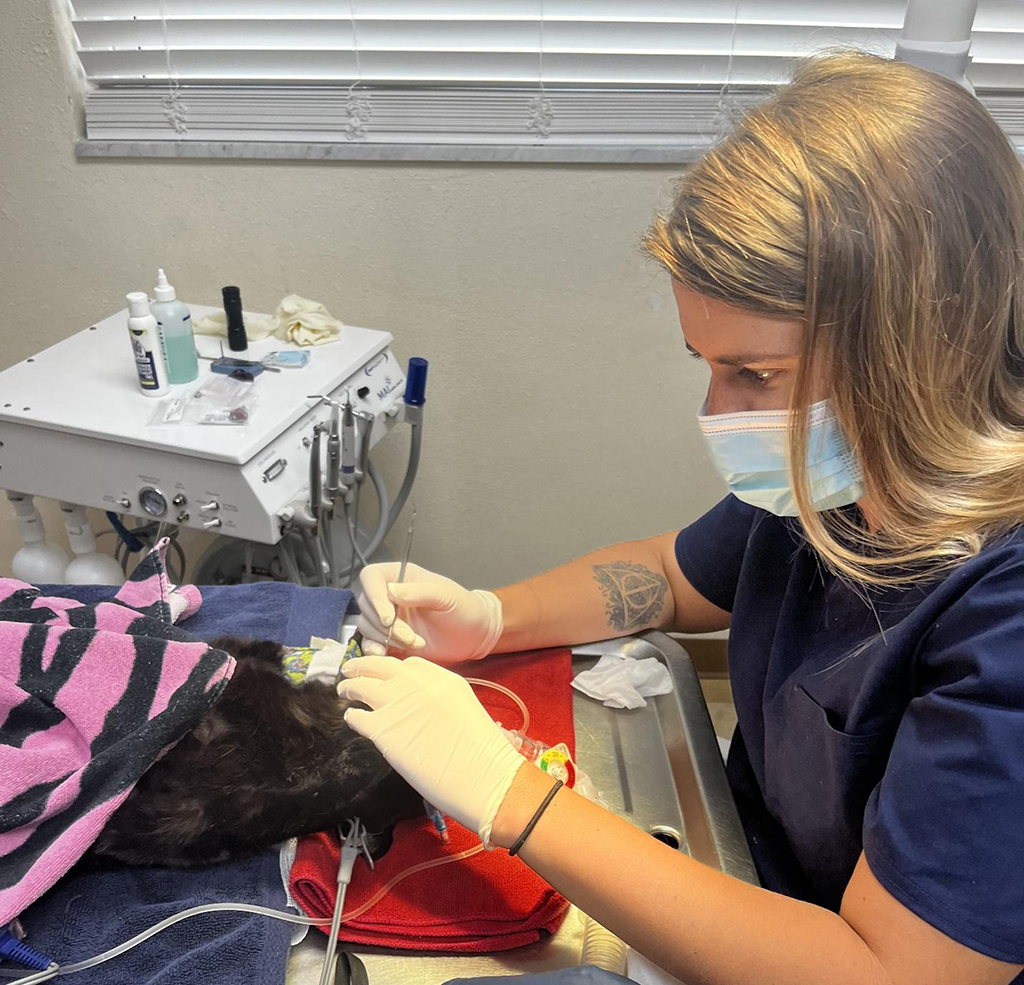The Significance Of Regular Pet Dental Care

Dental Care
Could you imagine living your life without ever brushing your teeth? Stinky breath and tartar build-up would make anyone uncomfortable. So why let your pet live their whole life without routine dentals or brushings? There are many health risks in not prioritizing pet dental care. With that being said, we will be discussing the common symptoms you should look for when a pet needs dental care, common ailment and illnesses caused by dental neglect, common preventative care you can add to your routine, and what a Complete Veterinary Oral Care Procedure can look like.
Symptoms
There are various symptoms that could indicate that dental attention is needed. These include:
- Smelly breath
- Excessive drooling
- Discolored teeth and/or tartar build-up
- Bleeding from the mouth
- Swelling in the mouth or around the area of the mouth
- Broken or loose teeth
- Decreased interest in food or complete refusal to eat
If you notice any of these symptoms in your pet, you should seek a veterinary evaluation to determine the cause and if a dental procedure is necessary.
Diseases and Illnesses
There are many common problems that can develop if dental symptoms are ignored. Pets don’t get cavities as often as humans would; However, there are many similar problems that pets can have. These include:
- Abscesses and/or infected teeth
- Cysts or tumors
- Periodontal disease
- Broken teeth or roots
- Malformities which cause misalignment to the teeth and bite
These symptoms and illnesses can cause severe discomfort or long-term problems such as organ damage if not correctly addressed.
Preventative Care
The best way to avoid these ailments is starting with early (and continuing) preventative care. There are a few ways you can start with at-home prevention. These include teeth brushing with pet-safe toothpaste, using dental treats, or specific hard chews or toys meant to keep tartar build-up at bay. Starting an early routine with your pet can help them to be comfortable with the process of teeth brushing; However, it’s never too late to start. The other and overall best prevention is to schedule regular dental cleanings for your pet so that a more invasive procedure can be avoided.
 Veterinary Dental Care
Veterinary Dental Care
Pet dental cleanings are a very similar process to human’s… two key differences are a preanesthetic bloodwork profile and the use of anesthesia during pet cleanings. The preanesthetic bloodwork is necessary to determine any underlining disease or concerns that would cause complications during anesthesia. We can’t tell our pets why they’re receiving a dental cleaning and that it benefits their health. Some may be fearful and try to escape, scratch, or bite. This use of anesthesia helps both the pet, the technician, and veterinarian stay safe during. The process begins with an IV catheter placement, this allows for induction. Once sedated, a technician can intubate the pet to ensure the pet will stay sedate during the cleaning with anesthetic gas and receiving proper oxygen. They quickly attach all monitoring equipment to your pet to monitor heart rate, oxygen levels, blood pressure, mucous membrane color, temperature, respiratory rate, pulse, and anesthetic level. After monitoring equipment is attached, a mouth rinse of chlorhexidine is next; a germicidal mouth wash that helps prevent bacteria. Next are x-rays of the teeth, roots, and surrounding jaw. This is to help determine any issues that may not be noticeable to the initial observation. If any teeth need to be removed, the veterinarian carefully extracts the teeth and uses dissolvable suturing. Once teeth are extracted (if they needed to be,) then the technician takes over to begin the dental cleaning. This process includes scaling the whole tooth which helps break down the built-up tartar and clean any remaining teeth of plaque. A blue light can be used to see if there is any left-over build-up, which then can be tackled with more scaling. After the scaling process is finished, polishing begins. The whole tooth is polished including all deep or shallow crevices. To finish the dental procedure, fluoride is added to the teeth which helps prevent future tartar build-up and can help with tooth sensitivity. After the procedure is completed, the pet is taken off anesthesia and begins the recovery process. During recovery, the pet’s temperature, heart rate, respiratory rate, and mucous membrane color are monitored. During the recovery process, your pet is stimulated to help wake them up. Extubating is a part of this process; after the pet is coherent enough to swallow hard multiple times the endotracheal tube is removed. The pet is monitored until they can adequately sit up on their own and are responsive to touch and sound. Complimentary ear cleanings and nail trimming are always a part of our dental cleanings and are done during the recovery period. After the pet is responsive on their own; temperature, behavior, and other vitals are regularly re-checked to ensure the pet is comfortable and well.
How can you say no to your pet and their dental health? Now that we know more about dental symptoms, illnesses and ailments, preventative care, and what our dental procedures involve, we can be more educated and prepared for our pet’s future and health. Our pets are family members, and they deserve to be treated as such!
